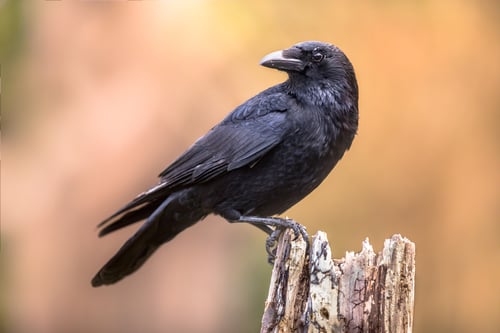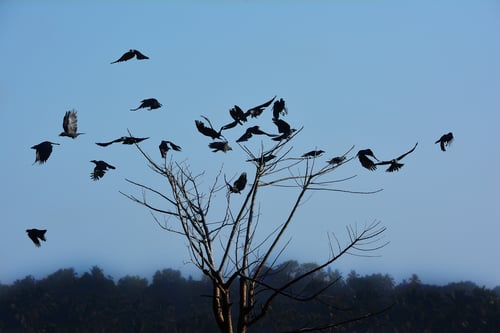Crows might be thought of as scary or as pests, but when you see a “murder” of crows in the air you might be surprised to learn they are a highly intelligent and social species that actually shares a few things in common with humans.
Crows are sometimes considered irritating because of their tendency to be noisy and generally unafraid of humans. Their population has grown steadily over the last few decades, because their intelligence and adaptability allows them to thrive in both urban and rural areas. They are opportunistic feeders and will eat things from insects, carrion, small animals, crops and anything else that is convenient to them.
 Resting Crow
Resting Crow
One of the more fascinating studies being done about crows and their intelligence has been a long term study done in Seattle. This study started with the trapping and banding of seven crows while wearing caveman masks. Later, the crows recognized the masks when worn around campus and scolded those wearing them. Even 16 years later, crows will be able to recognize the “faces” of the researchers wearing these masks.
This touches on an especially impressive aspect of a crow’s intelligence, their ability to learn socially rather than from direct experience and instinct only. Crows are extremely social birds that will flock together and trust the shared knowledge of others. So when some birds recognize that the caveman mask is bad and start diving and cawing harshly, the others will join in and learn to associate the mask-wearer as a threat.
 Murder of Crows
Murder of Crows
Crows are monogamous and mate for life. Most wild crows typically live up to 10 years old on average, but some individuals have been known to live almost to the age of 20! They also create strong familial bonds between related individuals helping with roosting and feeding the mother bird.
Another aspect of crow communities that are special is that they have been shown to recognize their dead and hold “funerals” for dead individuals, something that has only been observed in a few other species including elephants, dolphins and some primates. Crows have been observed gathering around the carcass of other crows and creating an unsettling scene to human witnesses. Scientists believe this can serve the purpose of learning about potential threats to be avoided.
So the next time you see a crow, hopefully you are able to understand how intelligent and social they are and not simply treat them as a pest or something to fear. If you are getting into the spooky fall spirit, don’t miss Walking Mountains Science Center’s annual Fright at the Museum, which runs from 10/20-10/30 and includes many fun events for all ages!
If you go…
What: Fright at the Museum (variety of events)
When: October 20-30, 2022, including Spy Science Spooktacular October 29-30
Where: Walking Mountains Science Center Avon Tang Campus
Cost: Some events are free, some have a fee
Visit www.walkingmountains.org to see the list of events
Reese Farrow is a Naturalist at Walking Mountains Science Center. He has greatly enjoyed learning and teaching about crows this season and hopes everyone else enjoys knowing more about these wonderful birds!









